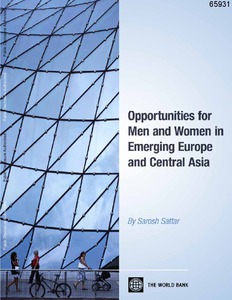Opportunities for men and women in emerging Europe and Central Asia

World Bank - Washington, DC
2012
105 p.
entrepreneurship ; gender ; labour market ; statistics ; wage differential
Central Europe ; Eastern Europe ; Central Asia
Women in Development and Gender Study
65931
Social sciences
English
Bibliogr.
"The countries of Central and Eastern Europe and Central Asia have a long history of striving for gender equality, especially in the public sphere. Not only was this an important goal during the socialist era, but governments continued to pursue gender equality even during the difficult years of transition. The governments in the region allocated substantial resources toward the health and education of both women and men. They also adopted legislation that treated women and men equally in the labor market and they provided child care services. During much of the last century, the region surpassed countries both developing and developed in establishing the equal treatment of women and men. This report reviews changes in gender inequalities in Europe and Central Asia over the last decade, with a particular focus on economic opportunities both in labor markets and in entrepreneurial activity. In addition, given the importance of health and education in opening up opportunities for men and women in the economic sphere, the report discusses the changes in human capital endowments in this area as well. Unfortunately, the lack of data prevents us from covering the role of other assets, such as property or financial assets, in broadening opportunities for women. The remainder of this executive summary is structured as follows. The next section, A, reviews the main aspects of the World Development Report on gender and development. The following sections, B and C, discuss the main messages of this report and policy priorities, respectively. Section D makes some closing remarks."
Digital
The ETUI is co-funded by the European Union. Views and opinions expressed are however those of the author(s) only and do not necessarily reflect those of the European Union or the ETUI.